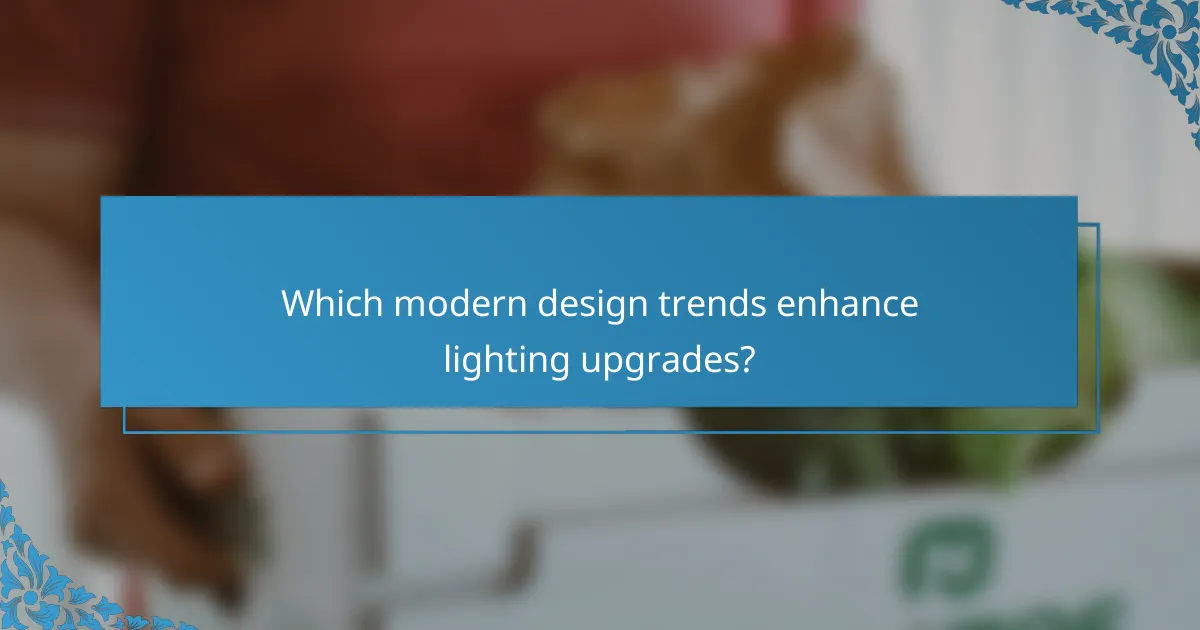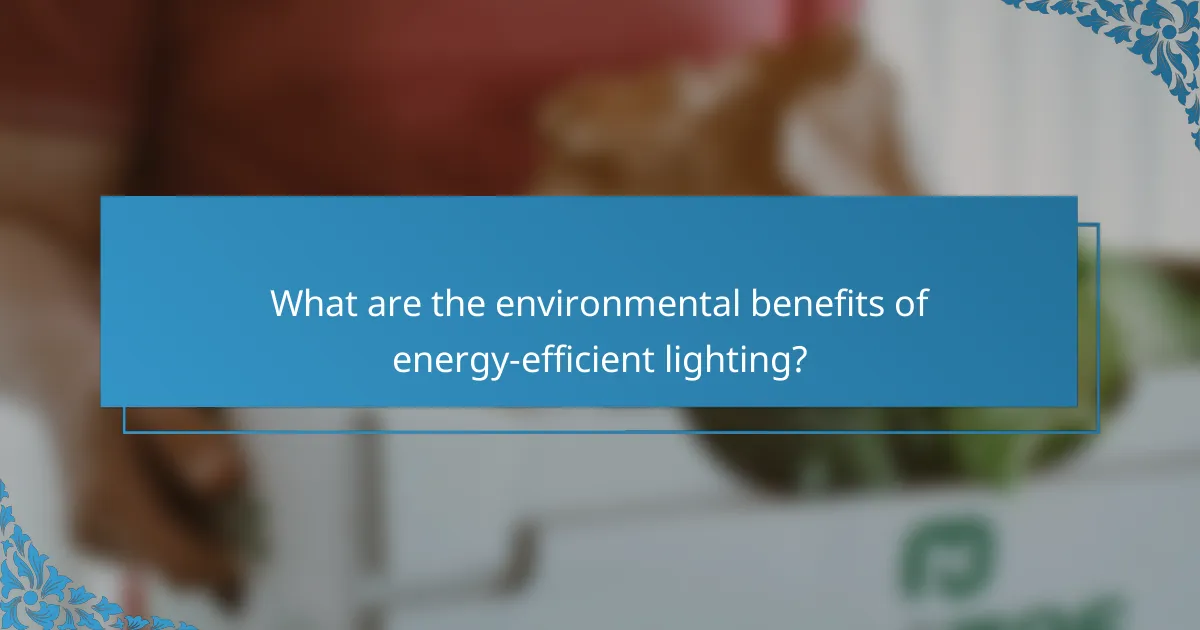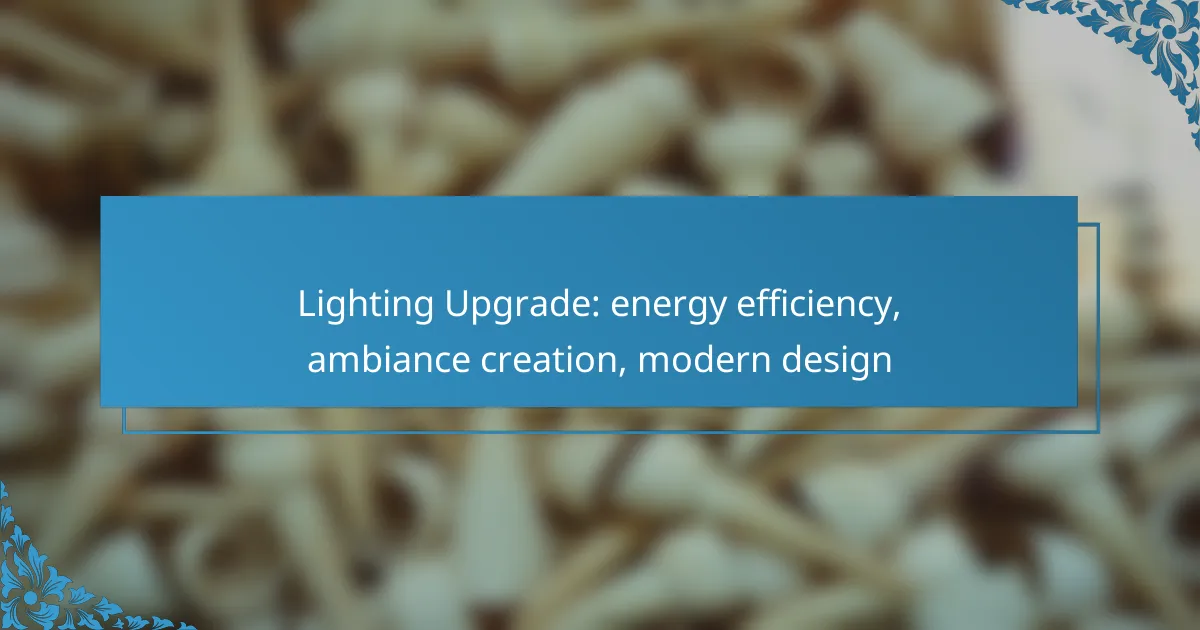Upgrading your lighting can transform your space by enhancing energy efficiency, creating inviting ambiance, and embracing modern design. By replacing outdated systems with energy-saving technologies, you not only reduce electricity costs but also contribute to a more sustainable environment. Incorporating warm white LED bulbs and smart lighting solutions can elevate the aesthetic appeal of your home while ensuring comfort and style.

How can lighting upgrades improve energy efficiency in Toronto?
Lighting upgrades can significantly enhance energy efficiency in Toronto by replacing outdated systems with modern, energy-saving technologies. This not only reduces electricity consumption but also lowers utility bills and minimizes environmental impact.
LED lighting benefits
LED lighting is one of the most effective ways to improve energy efficiency. These bulbs use up to 80% less energy than traditional incandescent bulbs and have a much longer lifespan, often lasting over 25,000 hours. This means fewer replacements and less waste, contributing to a more sustainable environment.
In addition to energy savings, LED lights offer better quality illumination, which can enhance the ambiance of any space. They are available in various color temperatures, allowing homeowners to create the desired mood while maintaining efficiency.
Smart lighting systems
Smart lighting systems can further enhance energy efficiency by allowing users to control their lights remotely and automate schedules. This means lights can be turned off when not in use or dimmed according to natural light levels, leading to additional savings on electricity bills.
These systems often integrate with home automation platforms, enabling features like motion detection and timers. For instance, lights can automatically turn off when a room is unoccupied, ensuring energy is not wasted.
Energy-efficient fixtures
Choosing energy-efficient fixtures is crucial for maximizing energy savings. Look for products that are labeled with ENERGY STAR certification, which indicates they meet strict efficiency guidelines. These fixtures often use less energy while providing the same level of brightness as traditional options.
Additionally, consider the placement and design of fixtures to optimize light distribution. For example, using fixtures that direct light where it’s needed can reduce the number of bulbs required, further enhancing energy efficiency in your home or business.

What are the best lighting options for creating ambiance in homes?
The best lighting options for creating ambiance in homes include warm white LED bulbs, dimmable lighting solutions, and layered lighting techniques. These choices enhance the aesthetic appeal of a space while improving energy efficiency and comfort.
Warm white LED bulbs
Warm white LED bulbs emit a soft, inviting light that closely resembles traditional incandescent bulbs. They are energy-efficient, consuming significantly less electricity while providing a similar level of brightness.
When selecting warm white LEDs, look for bulbs with a color temperature around 2700K to 3000K for the best ambiance. These bulbs are ideal for living rooms, bedrooms, and dining areas where a cozy atmosphere is desired.
Dimmable lighting solutions
Dimmable lighting solutions allow you to adjust the brightness of your lights, enabling you to create different moods throughout the day. This flexibility is particularly useful for spaces that serve multiple purposes, such as a dining room that transitions from bright to soft lighting during meals.
To implement dimmable lighting, ensure you choose compatible dimmer switches and bulbs. Consider using smart dimmers that can be controlled via smartphone apps for added convenience.
Layered lighting techniques
Layered lighting involves combining different types of lighting—ambient, task, and accent—to create a well-balanced and visually appealing environment. This technique enhances the functionality and aesthetic of a room.
For effective layering, use overhead fixtures for ambient light, table lamps for task lighting, and wall sconces or spotlights for accent lighting. Aim for a mix of light sources at various heights to achieve depth and interest in your space.

Which modern design trends enhance lighting upgrades?
Modern design trends that enhance lighting upgrades focus on creating energy efficiency, improving ambiance, and incorporating contemporary aesthetics. Key trends include minimalist lighting fixtures, industrial-style designs, and smart home integration, each offering unique benefits and considerations for homeowners.
Minimalist lighting fixtures
Minimalist lighting fixtures emphasize simplicity and functionality, often featuring clean lines and neutral colors. These designs can help create a calming atmosphere while maximizing natural light in a space.
When selecting minimalist fixtures, consider options like pendant lights or wall sconces that blend seamlessly with your decor. Look for energy-efficient LED bulbs to further enhance energy savings while maintaining a sleek appearance.
Industrial-style lighting
Industrial-style lighting draws inspiration from warehouses and factories, showcasing raw materials like metal and exposed bulbs. This trend adds a rustic yet modern touch to any room, making it a popular choice for urban settings.
To incorporate industrial lighting, consider using fixtures with a vintage finish or Edison bulbs. These elements can create a warm ambiance while also being energy-efficient, especially when paired with LED options.
Smart home integration
Smart home integration allows for automated control of lighting, enhancing both convenience and energy efficiency. Homeowners can adjust brightness, color, and scheduling through smartphone apps or voice commands.
When upgrading to smart lighting, choose systems compatible with existing home automation platforms. Look for features like dimming capabilities and energy monitoring to optimize usage and reduce electricity costs.

What factors should be considered before upgrading lighting?
Before upgrading lighting, it’s essential to evaluate factors such as the room’s function, existing electrical infrastructure, and compliance with local building codes. These considerations ensure that the new lighting enhances energy efficiency, ambiance, and modern design without causing issues or exceeding budgets.
Room function and layout
The function of a room significantly influences the type of lighting required. For instance, task-oriented spaces like kitchens or offices benefit from bright, focused lighting, while relaxation areas like living rooms may require softer, ambient lighting. Consider the layout as well; open spaces may need layered lighting to create depth and warmth.
Additionally, think about the furniture arrangement and how it interacts with light. Positioning lights to highlight specific areas or features can enhance the overall atmosphere. Use dimmers to adjust brightness levels based on activities, making the space more versatile.
Existing electrical infrastructure
Assessing the existing electrical infrastructure is crucial before making any lighting upgrades. Check the capacity of your current wiring and circuits to ensure they can handle the new fixtures, especially if you plan to install energy-efficient LED lights that may require different voltage levels.
Consider the placement of outlets and switches as well. Upgrading to modern lighting may necessitate relocating or adding electrical points to optimize functionality and aesthetics. Consulting with a licensed electrician can help identify any necessary modifications.
Local building codes in Ontario
In Ontario, compliance with local building codes is mandatory when upgrading lighting. These codes dictate safety standards, energy efficiency requirements, and installation practices. Familiarize yourself with the Ontario Electrical Safety Code, which outlines regulations for residential lighting installations.
Ensure that any new fixtures meet energy efficiency standards, which may qualify for rebates or incentives. It’s advisable to consult with local authorities or a qualified electrician to ensure all installations are up to code and avoid potential fines or safety hazards.

How much does a lighting upgrade cost in Canada?
A lighting upgrade in Canada typically costs between CAD 1,000 and CAD 3,500, depending on the scope of the project and the type of fixtures chosen. Factors such as labor, materials, and the complexity of installation can influence the final price.
Average installation costs
The average installation costs for a lighting upgrade can vary significantly based on the size of the space and the type of lighting being installed. For residential projects, homeowners might expect to pay around CAD 100 to CAD 200 per fixture, including both materials and labor.
Commercial upgrades may have higher costs due to larger spaces and more complex systems, with estimates ranging from CAD 150 to CAD 300 per fixture. It’s essential to obtain multiple quotes from licensed electricians to ensure a competitive price.
Cost-saving benefits of energy-efficient lighting
Upgrading to energy-efficient lighting, such as LED fixtures, can lead to substantial cost savings on electricity bills. These fixtures use significantly less energy than traditional incandescent bulbs, often reducing energy consumption by 50% or more.
Additionally, energy-efficient lighting has a longer lifespan, which means lower replacement costs over time. Many Canadian provinces offer rebates or incentives for upgrading to energy-efficient systems, further enhancing the financial benefits.
Financing options for upgrades
Financing options for lighting upgrades in Canada include personal loans, home equity lines of credit, and specialized energy efficiency financing programs. Many financial institutions offer loans specifically designed for home improvements, which can be a practical way to manage upfront costs.
Additionally, some municipalities and utilities provide financing programs that allow homeowners to pay for upgrades through their utility bills, spreading the cost over time. Researching local incentives and financing options can help maximize savings during the upgrade process.

What are the environmental benefits of energy-efficient lighting?
Energy-efficient lighting significantly reduces environmental impact by lowering energy consumption and minimizing greenhouse gas emissions. By transitioning to energy-efficient options, individuals and businesses can contribute to a healthier planet while enjoying cost savings.
Reduction in carbon footprint
Switching to energy-efficient lighting can lead to a substantial reduction in carbon emissions. Traditional incandescent bulbs emit more carbon dioxide due to their high energy consumption, while LED and CFL bulbs use less electricity, resulting in fewer emissions from power plants.
For example, replacing a standard 60-watt incandescent bulb with an 8- to 12-watt LED can reduce carbon emissions by several hundred kilograms over the bulb’s lifespan. This shift not only benefits the environment but also aligns with global efforts to combat climate change.
Lower energy consumption
Energy-efficient lighting consumes significantly less electricity compared to conventional options. LEDs and CFLs use about 75% less energy than incandescent bulbs, which translates to lower utility bills and reduced demand on energy resources.
For households and businesses, this means that upgrading lighting systems can lead to noticeable savings on monthly energy costs. Additionally, lower energy consumption helps decrease the strain on local power grids, especially during peak usage times.
Longer lifespan of fixtures
Energy-efficient lighting fixtures typically have a longer lifespan than traditional bulbs. For instance, LED bulbs can last up to 25,000 hours or more, compared to around 1,000 hours for incandescent bulbs. This longevity reduces the frequency of replacements, leading to less waste.
By investing in longer-lasting lighting solutions, consumers can minimize the environmental impact associated with manufacturing, packaging, and disposing of light bulbs. This not only conserves resources but also contributes to a more sustainable approach to lighting design.
